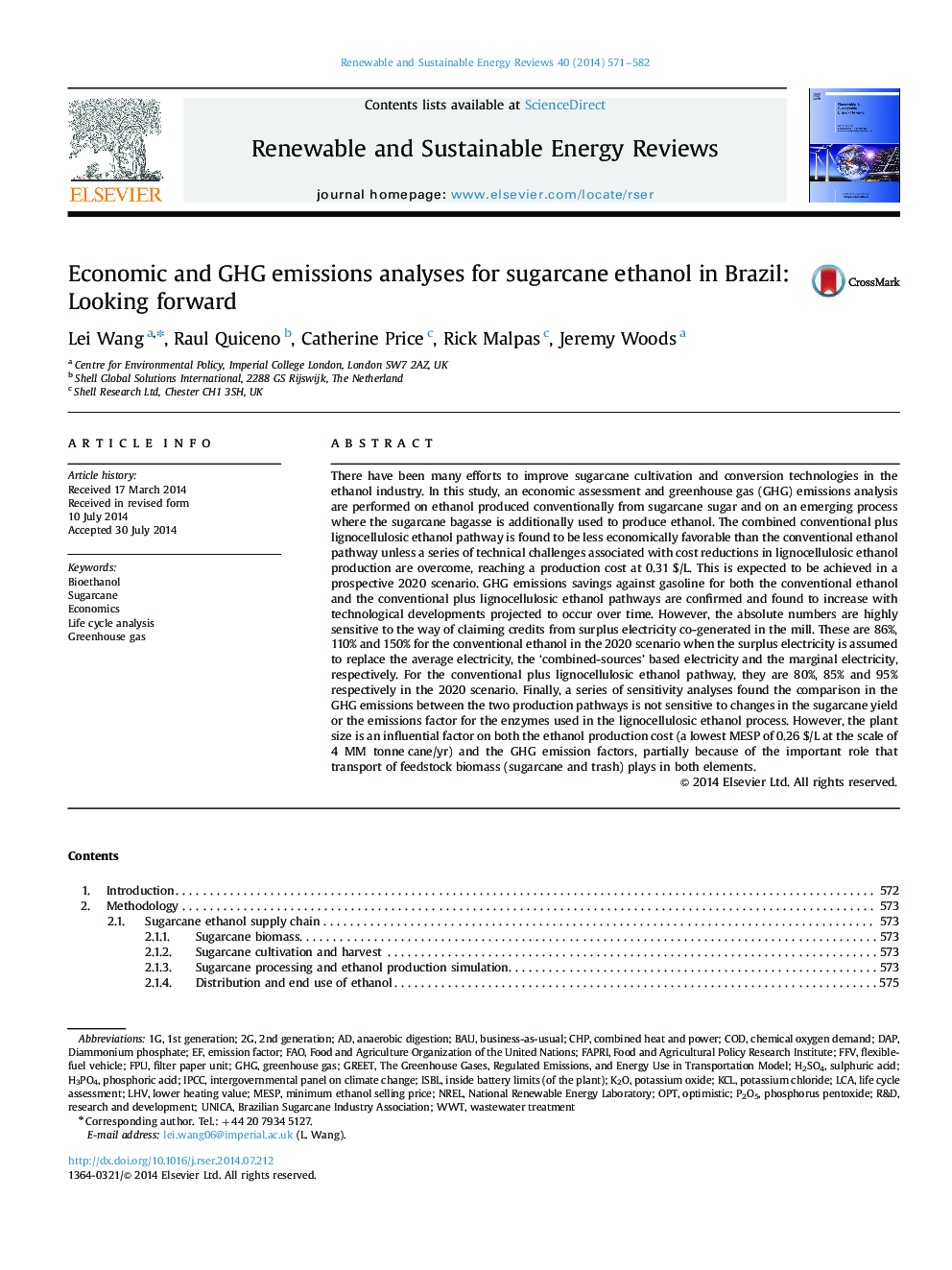| کد مقاله | کد نشریه | سال انتشار | مقاله انگلیسی | نسخه تمام متن |
|---|---|---|---|---|
| 8118833 | 1522345 | 2014 | 12 صفحه PDF | دانلود رایگان |
عنوان انگلیسی مقاله ISI
Economic and GHG emissions analyses for sugarcane ethanol in Brazil: Looking forward
ترجمه فارسی عنوان
تجزیه و تحلیل اقتصادی و انتشار گازهای گلخانهای برای اتانول نخود فرنگی در برزیل: پیش بینی می شود
دانلود مقاله + سفارش ترجمه
دانلود مقاله ISI انگلیسی
رایگان برای ایرانیان
کلمات کلیدی
FFVIPCCWWTNRELH3PO4LHVH2SO4GHGP2O5KClFPUK2OMESPOPTCHPDAPMinimum ethanol selling priceBaU - BAUNational Renewable Energy Laboratory - آزمایشگاه ملی انرژی تجدید پذیرlower heating value - ارزش حرارت پایین ترLCA - ارزیابی چرخه حیاتLife Cycle Assessment - ارزیابی چرخه عمر یا چرخه حیاتsulphuric acid - اسید سولفوریکPotassium oxide - اکسید پتاسیمBioethanol - بیواتانولLife cycle analysis - تجزیه و تحلیل چرخه زندگیResearch and development - تحقیق و توسعهR&D - تحقیق و توسعهCombined Heat and Power - ترکیب گرما و قدرتWastewater treatment - تصفیه فاضلابchemical oxygen demand - تقاضای اکسیژن شیمیاییdiammonium phosphate - دی آمونیوم فسفاتFood and Agriculture Organization of the United Nations - سازمان غذا و کشاورزی سازمان ملل متحدGREET - سلامEconomics - علم اقتصادFAO - فائوEmission factor - فاکتور انتشارPhosphoric acid - فسفریک اسیدSugarcane - نیشکرAnaerobic digestion - هضم بیهوازیIntergovernmental Panel on Climate Change - هیات بین دولتی در مورد تغییرات اقلیمیfilter paper unit - واحد کاغذ فیلترPhosphorus pentoxide - پنتوکسید فسفرCod - کادوBusiness-As-Usual - کار طبق معمولPotassium chloride - کلرید پتاسیمGreenhouse gas - گاز گلخانه ای
موضوعات مرتبط
مهندسی و علوم پایه
مهندسی انرژی
انرژی های تجدید پذیر، توسعه پایدار و محیط زیست
چکیده انگلیسی
There have been many efforts to improve sugarcane cultivation and conversion technologies in the ethanol industry. In this study, an economic assessment and greenhouse gas (GHG) emissions analysis are performed on ethanol produced conventionally from sugarcane sugar and on an emerging process where the sugarcane bagasse is additionally used to produce ethanol. The combined conventional plus lignocellulosic ethanol pathway is found to be less economically favorable than the conventional ethanol pathway unless a series of technical challenges associated with cost reductions in lignocellulosic ethanol production are overcome, reaching a production cost at 0.31 $/L. This is expected to be achieved in a prospective 2020 scenario. GHG emissions savings against gasoline for both the conventional ethanol and the conventional plus lignocellulosic ethanol pathways are confirmed and found to increase with technological developments projected to occur over time. However, the absolute numbers are highly sensitive to the way of claiming credits from surplus electricity co-generated in the mill. These are 86%, 110% and 150% for the conventional ethanol in the 2020 scenario when the surplus electricity is assumed to replace the average electricity, the 'combined-sources' based electricity and the marginal electricity, respectively. For the conventional plus lignocellulosic ethanol pathway, they are 80%, 85% and 95% respectively in the 2020 scenario. Finally, a series of sensitivity analyses found the comparison in the GHG emissions between the two production pathways is not sensitive to changes in the sugarcane yield or the emissions factor for the enzymes used in the lignocellulosic ethanol process. However, the plant size is an influential factor on both the ethanol production cost (a lowest MESP of 0.26 $/L at the scale of 4 MM tonne cane/yr) and the GHG emission factors, partially because of the important role that transport of feedstock biomass (sugarcane and trash) plays in both elements.
ناشر
Database: Elsevier - ScienceDirect (ساینس دایرکت)
Journal: Renewable and Sustainable Energy Reviews - Volume 40, December 2014, Pages 571-582
Journal: Renewable and Sustainable Energy Reviews - Volume 40, December 2014, Pages 571-582
نویسندگان
Lei Wang, Raul Quiceno, Catherine Price, Rick Malpas, Jeremy Woods,
